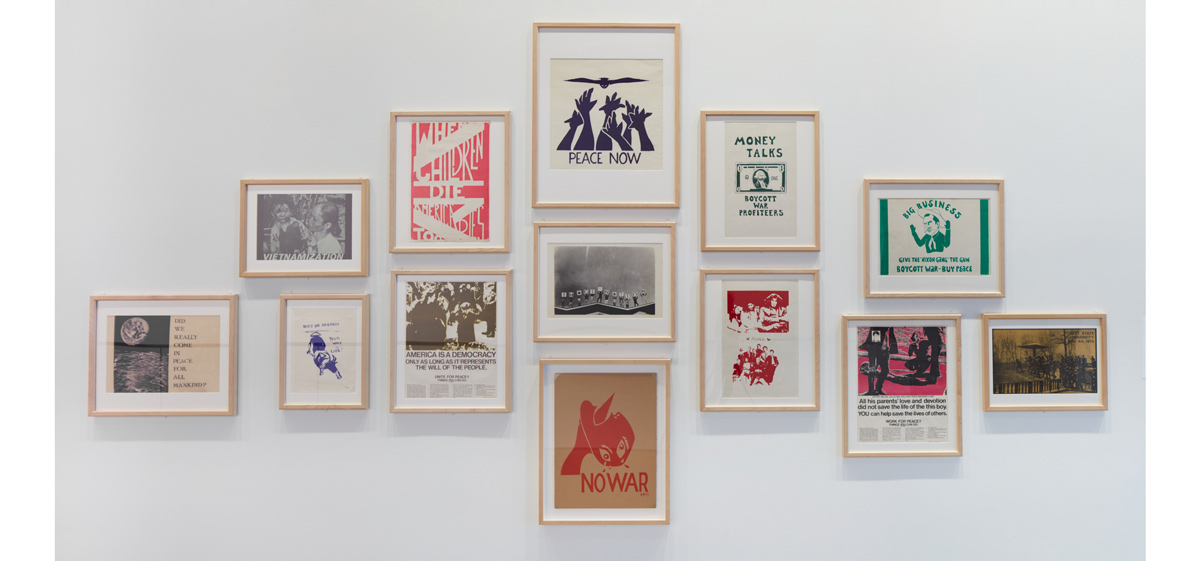Art for Human Rights
Selected works
Click image to enlarge in new window
-

In the spring of 1970, President Richard Nixon announced an expansion of the Vietnam War into Cambodia. The maneuver prompted outrage throughout an already divided nation. As protests erupted across college campuses, Nixon and other conservative politicians verbally attacked the university protesters; in Ohio, Governor James Rhodes directed state police and the National Guard to use force against student demonstrators, a policy that led to the deaths of four students at Kent State University on May 4, 1970. Immediately following the events at Kent State, UC Berkeley students, faculty, and staff formed an ad-hoc protest-poster workshop out of the College of Environmental Design, swiftly producing more than fifty thousand posters and plastering them across campus and in cities throughout the Bay Area.
The latest entry in the museum’s ongoing Art for Human Rights series, Peace Now! commemorates the fiftieth anniversary of the poster workshop. This exhibition invites viewers to consider the materiality, ephemerality, and utility of posters as instruments of political intervention. The posters’ dynamic arrangement—echoing their haphazard postings in public spaces—highlights the sense of outrage, urgency, and vulnerability expressed by youth coming of age during this volatile moment in American history. -

Abu Ghraib 81
Fernando Botero, Columbia, b. 1932, charcoal on paper
In 2004, Seymour M. Hersh published “Torture at Abu Ghraib” in The New Yorker, exposing disturbing photographs of the brutalization of imprisoned Iraqi men and women by US military officers. In response, world-renowned artist Fernando Botero translated the photographs into dozens of drawings and paintings, which he then donated to BAMPFA in hopes of assuring this dark moment in history would not be forgotten. Botero’s gift inspired the inauguration of the Art for Human Rights exhibition series, which always features a work from the Abu Ghraib series.
BAMPFA, gift of the artist 2009.12.50 -

The 1970 Protest Poster Workshop at Sproul Hall
BAMPFA’s collection of posters from the 1970 poster workshop reveals multiplicity of style and material utilized to highlight a common theme of anti-violence. The lack of uniformity (or conformity) speaks to the collaborative and improvised nature of the posters’ creation. Each singular design provides some evidence for us now of the considerable number of young artists involved. Meanwhile, the variety of social, historical, rhetorical, and artistic evidence the countless ways in which the violence in Vietnam was linked to inequality or danger in the United States -

Notes from the Curator: about the center arrangement
A gallery arrangement activates politically engaged art for a museum audience, while the grouping speaks to the collective production and dissemination processes.
In his monograph on the May 1970 poster workshop, Posters for Peace, Dr. Thomas Benson addresses a debate over whether or not the protest posters could be considered art or political rhetoric. For his part, Benson did not address the issue of artistic merit. Rather, as a professor of rhetoric (the study of effective speaking and writing), Benson discussed the posters’ social impact employing rhetorical methodology.
In this exhibition, because of their context within an art museum, I present the posters as works of art. However, because of the heavy circumstances under which they were made, these objects needed to been properly contextualized. An artwork is just an object without context. Some posters lose context when shown alone. Like the students who made them, their anti-war message was most effective as a collective.
In addition, I wanted the posters to function in BAMPFA as they did on shop windows, walls, and fences in May of 1970.
The gallery arrangement (devoid of individual labels) emphasizes the collective power of the movement as well as the posters. The posters are most powerful (in that they best present their demands for peace now) as a group. -

Local Politics
This section highlights posters from BAMPFA’s collection that are associated with other iconic social movements in the Bay Area. In contrast to the hurried and anonymous process of the May 1970 workshop, known graphic artists created these stunning posters and professionally printed these designs. The three posters in this section speak to the struggles of various communities in the Bay Area who faced incarceration, discrimination, and displacement, among other threats. -

Angela, Barry Shapiro, 1971; offset printing on paper; 23 x 17 ⅜ in; BAMPFA, gift of Susan Meller.
On October 13, 1970, FBI agents arrested prominent writer, orator, and Civil Rights leader Angela Davis. Her arrest ignited the international “Free Angela” movement. Artists from Charles White to the Rolling Stones produced art and music inspired by the injustices she endured. This contribution to the Free Angela movement shows a headshot of Davis, in mid-speech, placed behind four vertical bars. Her face and hair contained within an open fist about to close in around her face. Created by Barry Shapiro—a Bay Area “artivist,” UC Berkeley alumnus, Davis’ former roommate—the poster “reveals [Davis’s] plight as a Black Power activist facing an angry establishment.” -

Untitled (Fight for the International Hotel), Rachael Romero, 1978; offset printing on paper; 24 ⅛ x 18 ½ in.; BAMPFA, gift of Susan Meller.
Artist and activist Rachael Romero created this poster to protest the sale and demolition of the International Hotel, a low-income residence in San Francisco that housed many Asian Americans. Following a 4 a.m. eviction of all tenants on August 4, 1977, a massive protest emerged led by Felix Ayson, who is featured at the poster’s center.
Romero’s employment of etching and a limited pallet stylistically alludes to print culture in Mexico, where politics and art had been deeply intertwined since the Mexican Revolution of 1910. This aesthetic language aligns Ayson’s demand for affordable housing with anti- capitalist sentiments of the Revolution. -
Bibliography
Thomas W. Benson, Posters for Peace: Visual Rhetoric & Civic Action (University Park, Pennsylvania: The Pennsylvania State University Press, 2015).
Peter Selz, The Art of Engagement: visual politics in California and beyond (Berkeley: University of California Press; San Jose: San Jose Museum of Art, 2016).







